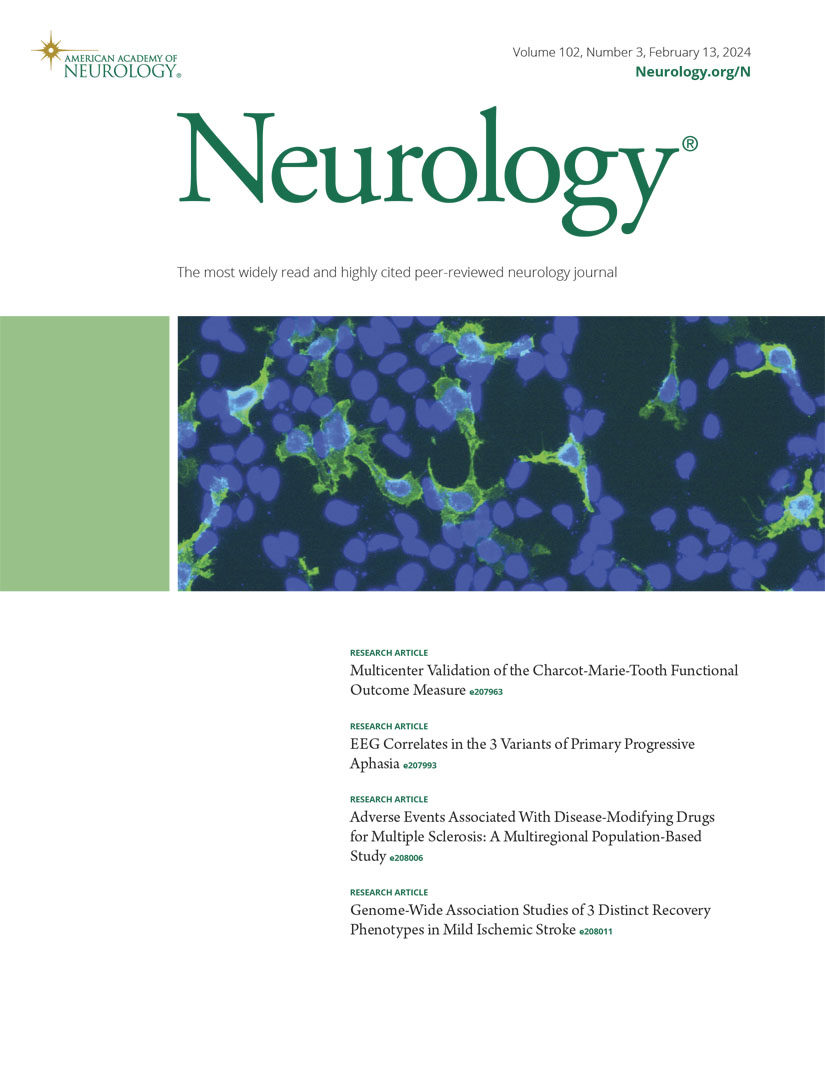Longitudinal Changes in Brain Diffusion Characteristics Associated With Cognition and Vascular Risk Factors: The ARIC-NCS Study.
IF 7.7
1区 医学
Q1 CLINICAL NEUROLOGY
引用次数: 0
Abstract
BACKGROUND AND OBJECTIVES It remains unclear whether longitudinal changes in brain microstructural integrity, measured by diffusion MRI, relate to cognition and vascular risks. We investigated whether annualized changes in fractional anisotropy (FA) and mean diffusivity (MD) are associated with changes in cognitive domains among nondemented older adults, and how these patterns differ by vascular risk factors. METHODS Data were longitudinally collected from the Atherosclerosis Risk in Communities Neurocognitive Study, conducted across 4 US sites with 6,471 participants attending the baseline assessment. Individuals who underwent diffusion MRI and neurocognitive evaluations at least twice between 2011 and 2019 were included; those with baseline dementia were excluded. Linear mixed-effects models assessed associations between FA and MD values in 140 brain regions and domain-specific cognitive scores (executive function, language, and memory). Annualized changes in FA and MD values were compared between individuals with and without vascular risk factors. RESULTS 592 participants (mean age: 75.8 ± 4.6 years; 56% women) were followed for 6 years on average. A 1-SD decrease in FA values in the left cingulum bundle was associated with a 0.166-SD reduction in executive function (95% CI 0.065-0.267; p = 0.025) and a 0.158-SD reduction in language (95% CI 0.054-0.263; p = 0.031). In addition, a 1-SD increase in MD values in the left hippocampus was associated with a 0.191-SD reduction in memory (95% CI -0.306 to -0.076; p = 0.009). Significant differences in annualized changes in these FA and MD values were found depending on the presence or absence of type 2 diabetes and smoking. DISCUSSION Deterioration in microstructural integrity-reflected by lower FA in the left cingulum bundle and higher MD in the left hippocampus-was associated with declines in executive function, language, and memory. Furthermore, longitudinal changes in these FA and MD values had differences based on the presence of type 2 diabetes and smoking. These findings provide a foundational basis for future research to determine whether managing vascular risk factors can delay cognitive decline by affecting the microstructural integrity of the brain.与认知和血管危险因素相关的脑弥散特征的纵向变化:ARIC-NCS研究。
背景与目的目前尚不清楚,弥散MRI测量的脑微结构完整性的纵向变化是否与认知和血管风险有关。我们调查了分数各向异性(FA)和平均扩散率(MD)的年化变化是否与非痴呆老年人认知领域的变化有关,以及这些模式如何因血管危险因素而不同。方法纵向收集来自社区动脉粥样硬化风险神经认知研究的数据,该研究在美国4个地点进行,共有6471名参与者参加了基线评估。在2011年至2019年期间接受扩散MRI和神经认知评估至少两次的个体被纳入研究范围;基线痴呆患者被排除在外。线性混合效应模型评估了140个脑区FA和MD值与特定领域认知评分(执行功能、语言和记忆)之间的关联。在有和没有血管危险因素的个体之间比较FA和MD值的年化变化。结果592名参与者(平均年龄:75.8±4.6岁;(56%的女性)平均随访6年。左扣带束FA值降低1 sd与执行功能降低0.166 sd相关(95% CI 0.065-0.267;p = 0.025),语言水平下降0.158-SD (95% CI 0.054-0.263;P = 0.031)。此外,左侧海马体的MD值每增加1 sd,记忆就会减少0.191 sd (95% CI -0.306 ~ -0.076;P = 0.009)。这些FA和MD值的年化变化有显著差异,这取决于是否患有2型糖尿病和吸烟。微观结构完整性的恶化——反映在左侧扣带束FA降低和左侧海马体MD升高——与执行功能、语言和记忆的下降有关。此外,这些FA和MD值的纵向变化基于2型糖尿病和吸烟的存在而存在差异。这些发现为未来的研究提供了基础,以确定管理血管危险因素是否可以通过影响大脑的微观结构完整性来延缓认知能力下降。
本文章由计算机程序翻译,如有差异,请以英文原文为准。
求助全文
约1分钟内获得全文
求助全文
来源期刊

Neurology
医学-临床神经学
CiteScore
12.20
自引率
4.00%
发文量
1973
审稿时长
2-3 weeks
期刊介绍:
Neurology, the official journal of the American Academy of Neurology, aspires to be the premier peer-reviewed journal for clinical neurology research. Its mission is to publish exceptional peer-reviewed original research articles, editorials, and reviews to improve patient care, education, clinical research, and professionalism in neurology.
As the leading clinical neurology journal worldwide, Neurology targets physicians specializing in nervous system diseases and conditions. It aims to advance the field by presenting new basic and clinical research that influences neurological practice. The journal is a leading source of cutting-edge, peer-reviewed information for the neurology community worldwide. Editorial content includes Research, Clinical/Scientific Notes, Views, Historical Neurology, NeuroImages, Humanities, Letters, and position papers from the American Academy of Neurology. The online version is considered the definitive version, encompassing all available content.
Neurology is indexed in prestigious databases such as MEDLINE/PubMed, Embase, Scopus, Biological Abstracts®, PsycINFO®, Current Contents®, Web of Science®, CrossRef, and Google Scholar.
 求助内容:
求助内容: 应助结果提醒方式:
应助结果提醒方式:


